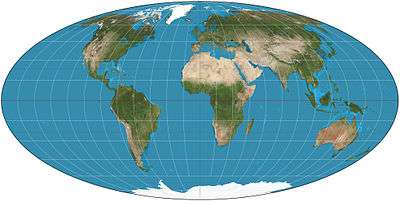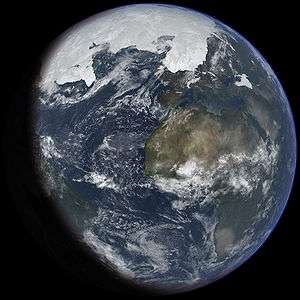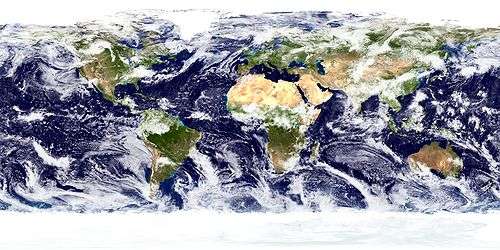Quaternary
Quaternary ( /kwəˈtɜːrnəri, ˈkwɒt.ərˌnɛr.i/ kwə-TUR-nə-ree, KWOT-ər-nerr-ee)[1] is the current and most recent of the three periods of the Cenozoic Era in the geologic time scale of the International Commission on Stratigraphy (ICS).[2] It follows the Neogene Period and spans from 2.588 ± 0.005 million years ago to the present.[2] The Quaternary Period is divided into two epochs: the Pleistocene (2.588 million years ago to 11.7 thousand years ago) and the Holocene (11.7 thousand years ago to today).[2] The informal term "Late Quaternary" refers to the past 0.5–1.0 million years.[3]
| Quaternary Period 2.58–0 million years ago | |
 Mollweide projection of the present-day Earth. | |
| Mean atmospheric O 2 content over period duration |
c. 20.8 vol % (104 % of modern level) |
| Mean atmospheric CO 2 content over period duration |
c. 250 ppm (1 times pre-industrial level) |
| Mean surface temperature over period duration | c. 14 °C (0 °C above modern level) |
The Quaternary Period is typically defined by the cyclic growth and decay of continental ice sheets associated with Milankovitch cycles and the associated climate and environmental changes that occurred.[4][5]
Research history
In 1759 Giovanni Arduino proposed that the geological strata of northern Italy could be divided into four successive formations or "orders" (Italian: quattro ordini).[6] The term "quaternary" was introduced by Jules Desnoyers in 1829 for sediments of France's Seine Basin that seemed clearly to be younger than Tertiary Period rocks.[7][8][9]
The Quaternary Period follows the Neogene Period and extends to the present. The Quaternary covers the time span of glaciations classified as the Pleistocene, and includes the present interglacial time-period, the Holocene.
This places the start of the Quaternary at the onset of Northern Hemisphere glaciation approximately 2.6 million years ago. Prior to 2009, the Pleistocene was defined to be from 1.805 million years ago to the present, so the current definition of the Pleistocene includes a portion of what was, prior to 2009, defined as the Pliocene.
| Subdivisions of the Quaternary System | ||||
|---|---|---|---|---|
| System/ Period |
Series/ Epoch |
Stage/ Age |
Age (Ma) | |
| Quaternary | Holocene | Meghalayan | 0 | 0.0042 |
| Northgrippian | 0.0042 | 0.0082 | ||
| Greenlandian | 0.0082 | 0.0117 | ||
| Pleistocene | 'Upper' | 0.0117 | 0.129 | |
| Chibanian or 'Middle' | 0.129 | 0.774 | ||
| Calabrian | 0.774 | 1.80 | ||
| Gelasian | 1.80 | 2.58 | ||
| Neogene | Pliocene | Piacenzian | 2.58 | 3.60 |
Subdivision of the Quaternary Period according to the ICS, as of May 2019.[10]
For the Holocene, dates are relative to the year 2000 (e.g. Greenlandian began 11,700 years before 2000). For the beginning of the Northgrippian a date of 8,236 years before 2000 has been set.[11] The Meghalayan has been set to begin 4,250 years before 2000.[10] 'Tarantian' is an informal, unofficial name proposed for a stage/age to replace the equally informal, unofficial 'Upper Pleistocene' subseries/subepoch. In Europe and North America, the Holocene is subdivided into Preboreal, Boreal, Atlantic, Subboreal, and Subatlantic stages of the Blytt–Sernander time scale. There are many regional subdivisions for the Upper or Late Pleistocene; usually these represent locally recognized cold (glacial) and warm (interglacial) periods. The last glacial period ends with the cold Younger Dryas substage. | ||||
Quaternary stratigraphers usually worked with regional subdivisions. From the 1970s, the International Commission on Stratigraphy (ICS) tried to make a single geologic time scale based on GSSP's, which could be used internationally. The Quaternary subdivisions were defined based on biostratigraphy instead of paleoclimate.
This led to the problem that the proposed base of the Pleistocene was at 1.805 Mya, long after the start of the major glaciations of the northern hemisphere. The ICS then proposed to abolish use of the name Quaternary altogether, which appeared unacceptable to the International Union for Quaternary Research (INQUA).
In 2009, it was decided to make the Quaternary the youngest period of the Cenozoic Era with its base at 2.588 Mya and including the Gelasian stage, which was formerly considered part of the Neogene Period and Pliocene Epoch.[12]
The Anthropocene has been proposed as a third epoch as a mark of the anthropogenic impact on the global environment starting with the Industrial Revolution, or about 200 years ago.[13] The Anthropocene is not officially designated by the ICS, but a working group has been working on a proposal for the creation of an epoch or sub-period.[14]
Geology
The 2.6 million years of the Quaternary represents the time during which recognizable humans existed. Over this geologically short time period, there has been relatively little change in the distribution of the continents due to plate tectonics.
The Quaternary geological record is preserved in greater detail than that for earlier periods.
The major geographical changes during this time period included the emergence of the Strait of Bosphorus and Skagerrak during glacial epochs, which respectively turned the Black Sea and Baltic Sea into fresh water, followed by their flooding (and return to salt water) by rising sea level; the periodic filling of the English Channel, forming a land bridge between Britain and the European mainland; the periodic closing of the Bering Strait, forming the land bridge between Asia and North America; and the periodic flash flooding of Scablands of the American Northwest by glacial water.
The current extent of Hudson Bay, the Great Lakes and other major lakes of North America are a consequence of the Canadian Shield's readjustment since the last ice age; different shorelines have existed over the course of Quaternary time.
Climate
The climate was one of periodic glaciations with continental glaciers moving as far from the poles as 40 degrees latitude. There was a major extinction of large mammals in Northern areas at the end of the Pleistocene Epoch. Many forms such as saber-toothed cats, mammoths, mastodons, glyptodonts, etc., became extinct worldwide. Others, including horses, camels and American cheetahs became extinct in North America.[15][16]
Quaternary glaciation
Glaciation took place repeatedly during the Quaternary Ice Age – a term coined by Schimper in 1839 that began with the start of the Quaternary about 2.58 Mya and continues to the present day.
Last glacial period

In 1821, a Swiss engineer, Ignaz Venetz, presented an article in which he suggested the presence of traces of the passage of a glacier at a considerable distance from the Alps. This idea was initially disputed by another Swiss scientist, Louis Agassiz, but when he undertook to disprove it, he ended up affirming his colleague's hypothesis. A year later, Agassiz raised the hypothesis of a great glacial period that would have had long-reaching general effects. This idea gained him international fame and led to the establishment of the Glacial Theory.
In time, thanks to the refinement of geology, it has been demonstrated that there were several periods of glacial advance and retreat and that past temperatures on Earth were very different from today. In particular, the Milankovitch cycles of Milutin Milankovitch are based on the premise that variations in incoming solar radiation are a fundamental factor controlling Earth's climate.
During this time, substantial glaciers advanced and retreated over much of North America and Europe, parts of South America and Asia, and all of Antarctica. The Great Lakes formed and giant mammals thrived in parts of North America and Eurasia not covered in ice. These mammals became extinct when the glacial period Age ended about 11,700 years ago. Modern humans evolved about 315,000 years ago. During the Quaternary Period, mammals, flowering plants, and insects dominated the land.
References
- https://www.dictionary.com/browse/quaternary
- Cohen, K.M.; Finney, S.C.; Gibbard, P.L.; Fan, J.-X. "International Chronostratigraphic Chart 2013" (PDF). stratigraphy.org. ICS. Retrieved 15 June 2014.
- Earthquake Glossary - Late Quaternary U.S. Geological Survey
- Denton, G.H.; Anderson, R.F.; Toggweiler, J.R.; Edwards, R.L.; Schaefer, J.M.; Putnam, A.E. (2010). "The Last Glacial Termination". Science. 328 (5986): 1652–1656. CiteSeerX 10.1.1.1018.5454. doi:10.1126/science.1184119. PMID 20576882.
- Lowe, J.J.; Walker, M.J.C. (1997). Reconstructing Quaternary Environments. Routledge. ISBN 978-0582101661.
- See:
- Arduino, Giovanni (1760). "Lettera Segonda di Giovanni Arduino … sopra varie sue osservazioni fatte in diverse parti del territorio di Vicenza, ed altrove, apparenenti alla Teoria terrestre, ed alla Mineralogia" [Second letter of Giovani Arduino … on his various observations made in different parts of the territory of Vincenza, and elsewhere, concerning the theory of the earth and mineralogy]. Nuova Raccolta d'Opuscoli Scientifici e Filologici [New collection of scientific and philogical pamphlets] (in Italian). 6: 133 (cxxxiii)–180(clxxx). Available at: Museo Galileo (Florence (Firenze), Italy) From p. 158 (clviii): "Per quanto ho potuto sinora osservavare, la serie di questi strati, che compongono la corteccia visibile della terra, mi pare distinta in quattro ordini generali, e successivi, senza considerarvi il mare." (As far as I have been able to observe, the series of these layers that compose the visible crust of the earth seems to me distinct in four general orders, and successive, not considering the sea.)
- English translation: Ell, Theodore (2012). "Two letters of Signor Giovanni Arduino, concerning his natural observations: first full English translation. Part 2". Earth Sciences History. 31 (2): 168–192. doi:10.17704/eshi.31.2.c2q4076006wn7751.
- Desnoyers, J. (1829). "Observations sur un ensemble de dépôts marins plus récents que les terrains tertiaires du bassin de la Seine, et constituant une formation géologique distincte; précédées d'un aperçu de la nonsimultanéité des bassins tertiares" [Observations on a set of marine deposits [that are] more recent than the tertiary terrains of the Seine basin and [that] constitute a distinct geological formation; preceded by an outline of the non-simultaneity of tertiary basins]. Annales des Sciences Naturelles (in French). 16: 171–214, 402–491. From p. 193: "Ce que je désirerais … dont il faut également les distinguer." (What I would desire to prove above all is that the series of tertiary deposits continued – and even began in the more recent basins – for a long time, perhaps after that of the Seine had been completely filled, and that these later formations – Quaternary (1), so to say – should not retain the name of alluvial deposits any more than the true and ancient tertiary deposits, from which they must also be distinguished.) However, on the very same page, Desnoyers abandoned the use of the term "quaternary" because the distinction between quaternary and tertiary deposits wasn't clear. From p. 193: "La crainte de voir mal comprise … que ceux du bassin de la Seine." (The fear of seeing my opinion in this regard be misunderstood or exaggerated, has made me abandon the word "quaternary", which at first I had wanted to apply to all deposits more recent than those of the Seine basin.)
- "Late Quaternary Fluvial and Coastal Sequences Chapter 1: Introduction" (PDF). Retrieved March 26, 2017.
- Wiz Science™ (2015-09-28), Quaternary - Video Learning - WizScience.com, retrieved 2017-03-26
- Cohen, K. M.; Finney, S. C.; Gibbard, P. L.; Fan, J.-X. (January 2020). "International Chronostratigraphic Chart" (PDF). International Commission on Stratigraphy. Retrieved 23 February 2020.
- Mike Walker; et al. (December 2018). "Formal ratification of the subdivision of the Holocene Series/Epoch (Quaternary System/Period)" (PDF). Episodes. Subcommission on Quaternary Stratigraphy (SQS). 41 (4): 213–223. doi:10.18814/epiiugs/2018/018016. Retrieved 11 November 2019. This proposal on behalf of the SQS has been approved by the International Commission on Stratigraphy (ICS) and formally ratified by the Executive Committee of the International Union of Geological Sciences (IUGS).
- See the 2009 version of the ICS geologic time scale
- Zalasiewicz, J.; Williams, M.; Haywood, A.; Ellis, M. (2011). "The Anthropocene: a new epoch of geological time?" (PDF). Philosophical Transactions of the Royal Society A. 369 (1938): 835–841. doi:10.1098/rsta.2010.0339. PMID 21282149.
- "Working Group on the 'Anthropocene'". Subcomission on Quaternary Stratigraphy. Retrieved 16 June 2014.
- Haynes. "Stanford Camelops" (PDF). Archived from the original (PDF) on 2014-03-09.
- "Extinct American Cheetah Fact Sheet". library.sandiegozoo.org. Archived from the original on 2016-03-04. Retrieved 2015-12-10.
External links
| Wikisource has original works on the topic: Cenozoic#Quaternary |
- Subcommission on Quaternary Stratigraphy
- Stratigraphical charts for the Quaternary
- Version history of the global Quaternary chronostratigraphical charts (from 2004b)
- Silva, P.G. C. Zazo, T. Bardají, J. Baena, J. Lario, A. Rosas, J. Van der Made. 2009, «Tabla Cronoestratigrafíca del Cuaternario en la Península Ibérica - V.2». [Versión PDF, 3.6 Mb]. Asociación Española para el Estudio del Cuaternario (AEQUA), Departamento de Geología, Universidad de Salamanca, Spain. (Correlation chart of European Quaternary and cultural stages and fossils)
- Welcome to the XVIII INQUA-Congress, Bern, 2011
- Quaternary (chronostratigraphy scale)

